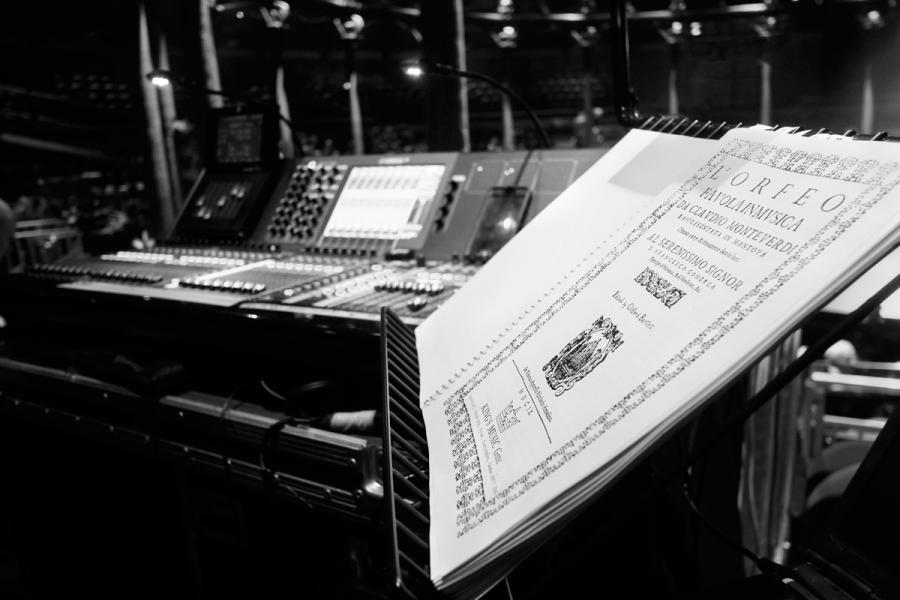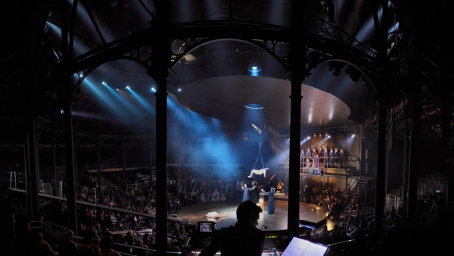Orfeo
We called it a challenge:
The Royal Opera House’s production of Orfeo, taking place in the round in Camden’s Roundhouse. The brief went something along the lines of:
"Two days to get set, sound and light in before the first rehearsal, for which everything must be completely ready.
By the way; the set includes a large flat ceiling panel over the stage so rigging points for speakers are limited to say the least. And there’s a ramp leading from the stage up to the rear of the auditorium, rising over fifteen feet as it does so.
Everything needs to be amplified for clarity, but in such a way that no-one notices."
It has to be one of the best starts to a year we have ever had.
Sound Intermedia and RNSS have been working closely together for many years and the relationship is incredibly close, each of us very comfortable and familiar with the working patterns and needs of the other. This project was only made possible because of that relationship. Ian Dearden led the project from an artistic point of view with Richard handling the system design and installation. Ian attended rehearsals over the Christmas period and fed us information that enable Tony Birch and his team to fine tune the prep. We arrived onsite at 0900 on Sunday 4th January and by early afternoon had everything that needed to be flown in the air, ready to allow the set to be built underneath it. As the set went in Richard, Tony and Ben Evans put in the control gear along with stage management comms, cue lights, standard and infra red cameras and a large number of video monitors of various sizes. The problem we had to solve was ensuring the cast could always see the musical director, wherever they were in the room and whatever direction they were facing. Carl Root, the production manager kept a grip on things without once appearing to be under pressure, whilst the stage management team, arriving at speed from rehearsals couldn’t have been more friendly.

By the time Ian needed to hear the system on day two, we were ready, but the quiet time scheduled to tune the system never materialised. Ian was confident enough of the system that he managed to do most of the tuning live, leaving Simon Hendry to operate as he endlessly circled the auditorium with an Ipad connected to the console- a CL5. Ian demonstrated yet again that he really can listen. It’s a rare thing.
Holly Arthur joined the team direct from another job and took over radio mic wrangling. It is not often a crew member gets such high praise from every quarter, but Holly managed to combine iron discipline with huge warmth and good humour to great effect. Not even Ian actually knew where exactly she hid the mics on the cast, but they worked perfectly on every performance. Ben stayed on as system tech for the run, matching Holly’s dedication and enthusiasm right through to the end of the get out.
The end result was fantastic. Ian was delighted and kindly sent through not only his thanks but forwarded a couple of reviews:
David Nice, Artsdesk:theartsdesk.com
…….It all not only looks austerely beautiful in the spare designs of Tom Piper – he of the Tower’s simple poppy-river of blood – with powerful lighting by Jean Kalman, but it sounds amazing too. I’m not sure I would have known, had the press officer not been sure to tell some of us before we went in, that discreet amplification had been used, for whatever Sound Intermedia had done merely enhanced the gorgeousness of Monteverdi’s 21-piece orchestra and left the voices to engage at close quarters.
David Karlin, Bachtrack: www.bachtrack.com
This production also killed one particular sacred cow, namely that you can't mike opera without wrecking it. There was amplification, but I didn't hear a single adverse artifact as a result. The effect was merely that voices didn't disappear when singers were facing away from me (the Roundhouse, to state the obvious, is round, so this happens quite a lot). If I hadn't been told before the performance that amplification was in use, I might easily have missed it, unless I'd been paying attention and realising that the singers weren't straining as hard as usual so that diction was exceptionally clear. Surtitles were provided, but they were only really needed in the ensemble pieces.
Conductor: Christopher Moulds
Director: Michael Boyd
Set design: Tom Piper
Production manager: Carl Root
Audio:
Ian Dearden for Sound Intermedia with RNSS
Whatever the scale of your project we'd like to help. Please contact us on Tel: 020 7593 0011
